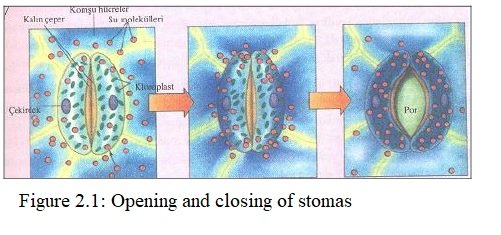Table of Contents
ToggleWater Loss in Plants
Transpiration (Sweating)
The water taken in plants plays a very important role in various vital activities. However, it is also known that most of the water taken is given out from the plant in any way. This phenomenon, which is generally known as water loss in plants, is the release of water from plants into the air in the form of vapor or exiting as liquid.
There is a certain water vapor absorption force that changes according to the dry and humid weather. The drying of the laundry also happens thanks to this suction force of the air. Since the suction force of the air is less in humid air, the laundry does not dry in such air. Since the suction force of the air is high in dry weather, the laundry dries quickly. Thanks to the suction force of the air, the release of water vapor from the parts of the plant in contact with the air is called transpiration.
Transpiration event is not only a physical evaporation event, but also a physiological event related to the vitality of the plant. Since evaporation is high on large surfaces, transpiration is primarily done by the leaves, since their surfaces are also large in plants. The density of each leaf cell that loses some water as a result of perspiration increases, and therefore the suction force increases. Leaf cells with increased suction force absorb water from the trunk’s transmission pipes. Thus, the change in water surface tension between the upper and lower parts of the wood pipes causes the water to be drawn upwards. As a result, the stem absorbs water from the root. The root also becomes able to take water from the soil again.
We can collect the importance of traspiration for plants under two main headings:
– To provide the plant with continuous water and dissolved substances in the water
– Protecting the plant from severe heat damage by preventing the plant from overheating

The Role of Stomas in Transpiration
The outer surface of leaves and other organs is generally covered by the cuticle. There is very little sweating from the cuticle. Transpiration basically takes place through structures called stomata (pores), which are usually on the lower surface, sometimes on the upper surface, and sometimes on both the lower and upper surfaces of the leaves. Stomata also provide the plant’s gas exchange. Stomas adjust sweating by opening and closing according to various situations. In this way, the plant is prevented from losing too much water.
Stomata consist of two closing cells and adjacent cells. The stomatal cells are abundant with chloroplasts and the dorsal wall is thin and the abdominal wall is thick. There is a hole between the closing cells.
Stomach cells with abundant chloroplasts synthesize glucose by photosynthesizing intensely in light environment. Thus, the osmotic values of the stomatal cells increase and there is an intense water inflow from the neighboring cells to the stomatal cells. As a result, the increased turgor pressure stretches the thin dorsal walls of the stomatal cells, allowing the stomata to open. Thus, the water vapor in the pore space is given to the air.
Since stomatal cells do not photosynthesize in the dark, glucose concentration decreases and osmotic values decrease. In this case, the water in the stomatal cells passes to the neighboring cells. The stomatal cell that loses water shrinks and closes. This stops the water vapor escaping.
Factors Affecting Transpiration
We can examine the factors affecting sweating by dividing them into two:
– Genetic factors: The structure of the stomata, their location, the number of stomata, the thickness of the cuticle, the amount of hair on the leaf, the leaf area and the osmotic pressure of the leaf cells are among the genetic factors.
– Environmental factors: The humidity of the air, wind, light and heat, the amount of water in the soil are included in the environmental factors.
Root Pressure
The water density of the stem cells is less than the water density of the soil. Due to the osmotic pressure arising from this density difference, there is intense water inflow from the soil to the root cells. Thus, a water pressure is created from the stem cells filled with water towards the wood pipes. This force in the root is called root pressure. If the stem of a plant is cut close to the ground when water absorption is high, it is seen that liquid comes out of this region. This proves the existence of liquid root pressure. Root pressure can raise water up to 25–30 meters high.
Liquid Water Loss in Plants
Water loss in plants does not always occur in the form of steam. Plants lose water, albeit a little, in liquid form. Loss of water in liquid form occurs in two ways.
Living
The loss of water as a liquid due to root pressure from the wounds (pruning) is called living. This phenomenon, which many people see clearly in vineyard pruning, in particular, occurs when root pressure pushes water from the bottom up.
Dripping (Gutation)
The root pressure pushing the water upwards causes the water to come out in the form of droplets from special structures called hydatids in the leaves of some plants in natural situations. This phenomenon, which can be seen very well in many plants, especially in the early morning hours, and appears with the effect of root pressure, is called guttation.
Secretion
Some plants, apart from living and dripping, in some cases throw out the water in their bodies in the form of different secretions. These secretions are made for the following purposes:
– Ensuring pollination in flowers by producing nectar that feeds insects
– Protecting the body from microbes by producing resin and tannin
– Secreting the fragrances of flowers and fruits
– Secreting fluids that enable insectivorous plants to digest insects
– secrete milky liquid to prevent some plants from being eaten by animals
